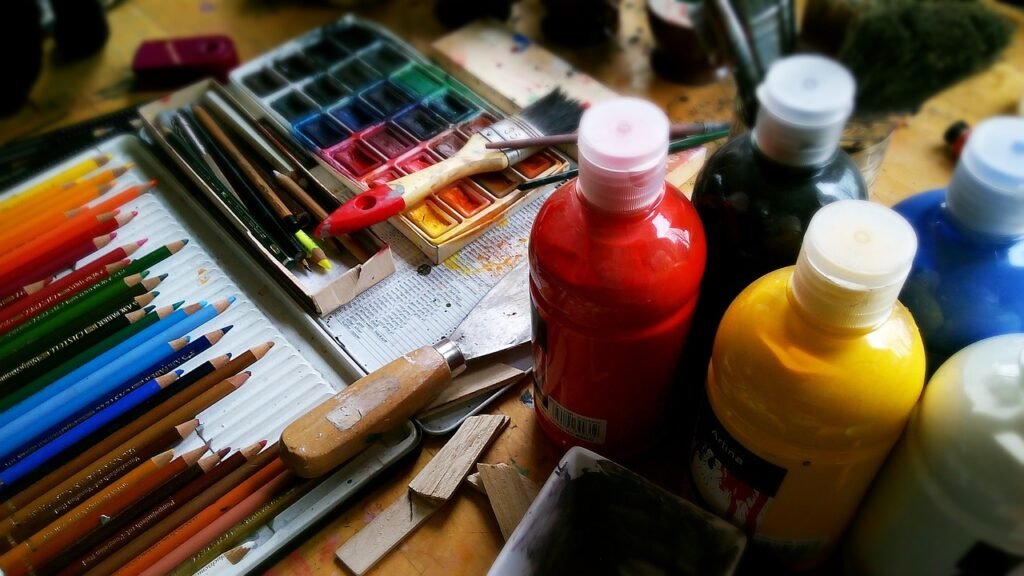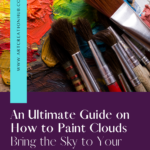
Are you curious about how to paint clouds? Do you want to learn how to create realistic and stunning cloudscapes?
Whether you’re a beginner or a professional artist, you’ll be able to learn the best techniques for painting clouds with ease.
In this blog post, we will explore seven techniques for painting clouds like a pro. With these methods, you’ll be able to capture the beauty of clouds and create breathtaking scenes on canvas. So read on to learn how to paint clouds with ease!
- Understanding Clouds as an Artistic Subject
- Preparing Your Painting Materials and Setup
- Mixing and Blending Colors for Clouds
- Techniques for Capturing the Shape and Movement of Clouds
- Using Different Brushstrokes to Create Realistic Clouds
- Adding Detail and Depth to Your Clouds
- Enhancing the Mood and Atmosphere with Clouds in Your Painting
Understanding Clouds as an Artistic Subject

Clouds have long been a popular subject in art, and for good reason. Their ethereal beauty and ever-changing forms make them a captivating subject for painters.
Understanding clouds as an artistic subject allows artists to capture their essence and convey a sense of tranquility, drama, or even mystery in their paintings.
Clouds have a unique ability to evoke emotion and create a mood in a painting. Their soft, billowy forms can add a sense of calm and serenity to a landscape, while dark and stormy clouds can convey tension and foreboding.
By studying the different types of clouds and their characteristics, artists can choose the perfect cloudscape to suit the mood they wish to create.
Clouds also offer a range of aesthetic possibilities for painters. From fluffy cumulus clouds to wispy cirrus clouds, each type has its own distinct visual appeal.
Artists can experiment with different brushstrokes and techniques to capture the texture and movement of clouds, whether it’s the delicate wisps of a high-altitude cloud or the bold, dramatic strokes of a storm cloud.
When it comes to cloud painting, it’s important to consider the composition of the painting as a whole. Clouds can serve as a focal point, leading the viewer’s eye through the painting and adding depth and dimension.
They can also be used to frame other elements in the painting, such as a mountain range or a serene seascape. By understanding the role of clouds in composition, artists can create balanced and visually appealing paintings.
Preparing Your Painting Materials and Setup

Before you start painting clouds, it’s important to gather all the necessary materials and set up your workspace.
By properly preparing your painting materials and setup, you can ensure a smooth and enjoyable painting process.
First, gather your painting supplies. You will need a variety of brushes in different sizes and shapes, such as flat brushes for broad strokes and round brushes for more detailed work.
Consider investing in high-quality brushes, as they can greatly impact the final outcome of your cloud paintings. Additionally, have a palette knife on hand for mixing colors and creating texture.
Next, choose the right paints for your cloud painting.
Acrylic paints are a popular choice for cloud painting due to their versatility and quick drying time.
Oil paints can also be used, but they require longer drying times and additional ventilation due to their fumes.
Consider experimenting with different types of paints to see which ones you prefer working with for cloud painting.
In terms of colors, start with a basic palette that includes blues, whites, and grays. These colors will form the foundation for your cloud paintings.
For a more realistic and dynamic effect, consider adding other colors such as purples or oranges to represent the various hues found in different types of clouds.
Experiment with different color combinations to find the ones that best capture the mood and atmosphere you want to convey in your cloud paintings.
Once you have gathered your painting supplies and chosen your paints, it’s time to set up your workspace. Find a well-lit area where you can comfortably work on your cloud paintings.
Make sure to cover your workspace with a drop cloth or plastic sheet to protect it from paint spills.
Set up your easel or painting surface at a comfortable height and angle that allows you to have a clear view of your work.
Having a clean and organized workspace is essential for staying focused and productive.
Keep your brushes and paints organized and within easy reach. Consider using a palette with separate wells for mixing colors, as this will help you keep your colors clean and prevent them from becoming muddy.
By properly preparing your painting materials and setting up your workspace, you can set yourself up for success in your cloud painting journey.
Take the time to gather your supplies, choose the right paints and colors, and create a clean and organized workspace.
With these preparations in place, you’ll be ready to dive into the magical world of cloud painting and create stunning and aesthetic paintings that capture the beauty of the skies above.
Mixing and Blending Colors for Clouds

One of the key elements in creating realistic and stunning cloudscapes is the ability to mix and blend colors effectively.
The right color palette can make all the difference in capturing the ethereal beauty and mood of clouds in your paintings. In this section, we will explore various techniques for mixing and blending colors to create aesthetic paintings of clouds.
When it comes to painting clouds, it’s important to understand that they are not just white. In fact, clouds can have a wide range of colors, from pale blues and grays to warm pinks and purples during a sunset or sunrise.
By mixing and blending different shades and tones, you can create depth and dimension in your clouds, making them come alive on the canvas.
Start by selecting a base color for your clouds, such as a light blue or gray. This will serve as the foundation for your cloud painting.
Then, experiment with different shades and tones to create variation and realism. Use a palette knife or brush to mix colors directly on your palette, gradually adding more white to create lighter areas and more black or gray to create shadows and definition.
Blending is also an essential technique for creating realistic clouds.
To blend colors seamlessly, use a soft brush or a blending brush to gently feather and soften the edges. This will create a smooth transition between different colors, mimicking the softness and blend of real clouds.
Remember to work with a light touch and let the colors flow together naturally.
In addition to blending colors, consider using glazing techniques to add depth and luminosity to your cloud paintings.
Glazing involves layering transparent or translucent colors over dry layers of paint to create a subtle and glowing effect. This technique is particularly effective for capturing the light and radiance of clouds, especially during sunrise or sunset scenes.
As you mix and blend colors for your clouds, remember to step back and observe your work from a distance. This will allow you to assess the overall effect and make any necessary adjustments.
Don’t be afraid to experiment and try different color combinations to achieve the desired mood and atmosphere in your cloud paintings.
Techniques for Capturing the Shape and Movement of Clouds

Clouds are not only visually captivating, but they also possess a sense of movement and shape that can add a dynamic quality to your paintings.
Capturing the shape and movement of clouds requires careful observation and the use of specific techniques. In this section, we will explore various techniques that will help you accurately portray the shape and movement of clouds in your paintings.
One technique to capture the shape of clouds is through the use of soft edges. Clouds often have soft, fluffy edges that blend seamlessly with the sky or other elements in your painting. To achieve this effect, use a soft brush and apply the paint in gentle, sweeping strokes.
Avoid using hard, defined edges as this can make the clouds look rigid and unrealistic. Instead, focus on creating smooth transitions between different areas of the cloud, allowing the shapes to flow and blend together.
Another technique for capturing the movement of clouds is through the use of directional brushstrokes. Clouds are constantly shifting and moving, and it is important to convey this sense of movement in your paintings.
By using brushstrokes that follow the direction of the cloud’s movement, you can create a more dynamic and lifelike representation.
For example, if the clouds are moving from left to right, use horizontal brushstrokes to mimic their movement. This will add a sense of energy and motion to your painting.
In addition to brushstrokes, consider the use of layers to create depth and dimension in your clouds. Start by laying down a base layer of paint to establish the overall shape and form of the clouds.
Then, gradually build up layers of paint to add depth and texture. By layering different shades and tones, you can create the illusion of depth and give your clouds a three-dimensional quality.
Experiment with transparent glazes to add luminosity and a sense of light passing through the clouds.
Using Different Brushstrokes to Create Realistic Clouds

When it comes to painting clouds, using different brushstrokes can make all the difference in creating realistic and breathtaking cloudscapes.
The right brushstroke technique can capture the texture, movement, and depth of clouds, bringing them to life on your canvas. In this section, we will explore several brushstroke techniques that will help you create stunning and realistic clouds in your paintings.
One popular brushstroke technique for painting clouds is the dry brush technique. This technique involves using a dry brush with only a small amount of paint on it.
By lightly dragging the dry brush across the canvas, you can create soft, wispy strokes that mimic the delicate and ethereal nature of clouds.
The dry brush technique is especially effective for capturing the feathery texture of high-altitude clouds or the soft edges of cumulus clouds.
Another technique for painting clouds is the stippling technique. This technique involves using a brush with stiff bristles and tapping it lightly against the canvas.
By dabbing the brush in a stippling motion, you can create a textured and fluffy appearance that is characteristic of many types of clouds. The stippling technique is particularly useful for capturing the volume and shape of cumulus clouds or the wispy texture of cirrus clouds.
If you want to create more dramatic and bold cloudscapes, consider using the impasto technique. This technique involves applying thick layers of paint to the canvas using a palette knife or a stiff brush.
By using short, confident strokes, you can create dynamic and three-dimensional clouds that seem to leap off the canvas. The impasto technique is great for capturing storm clouds or turbulent skies.
For more subtle and nuanced cloudscapes, the glazing technique can be used. This technique involves layering transparent or translucent colors over dry layers of paint to create a luminous effect.
By applying thin, transparent glazes over your clouds, you can create a sense of light passing through the clouds and add depth and dimension to your painting.
Adding Detail and Depth to Your Clouds

Now that you have a solid foundation for painting clouds, it’s time to take your artwork to the next level by adding detail and depth.
Adding these elements will bring your clouds to life and make them appear more realistic and captivating. In this section, we will explore some techniques to help you achieve this.
One way to add detail to your clouds is by using smaller brushes. Switching to a smaller brush allows you to add finer details, such as subtle variations in color and texture.
Use short, feathery strokes to mimic the soft edges of clouds and create a sense of movement. Pay attention to the way light interacts with the clouds and use different shades of white and gray to capture highlights and shadows.
Another technique to add depth to your clouds is by layering. Start with a base layer of paint and gradually build up layers of color and texture.
This will create a sense of depth and dimension, making your clouds appear more three-dimensional. Experiment with transparent glazes to create a luminous effect, especially when painting clouds during sunrise or sunset.
Don’t forget about the importance of contrast when adding detail and depth to your clouds. By using darker shades of gray or even a touch of black, you can create shadows and enhance the volume of your clouds.
Contrast can make your clouds stand out and give them a more dynamic appearance.
Consider adding other elements to your painting to complement your clouds and enhance the overall composition. For example, you could add a mountain range or a body of water to create a sense of scale and perspective.
This can make your clouds appear even more dramatic and majestic.
Enhancing the Mood and Atmosphere with Clouds in Your Painting

Clouds have the remarkable ability to enhance the mood and atmosphere of a painting. They can evoke a sense of tranquility, drama, or even mystery, depending on how they are portrayed.
In this section, we will explore techniques that will help you enhance the mood and atmosphere of your painting by focusing on the clouds.
One way to enhance the mood of your painting is to pay attention to the color palette of the clouds. Different colors can convey different emotions and atmospheres.
For example, soft, pastel colors can create a calm and peaceful mood, while dark and stormy colors can add tension and foreboding. Consider the overall mood you want to convey in your painting and choose the colors of your clouds accordingly.
The way you capture the lighting and shadows on the clouds can also greatly impact the mood of your painting.
Light and shadow can create depth and add a sense of realism to the clouds. For a more serene and peaceful mood, you may want to emphasize soft, diffused lighting that gently illuminates the clouds. On the other hand, for a more dramatic and intense mood, you can play with contrasting light and shadow, highlighting the peaks and valleys of the clouds.
Another way to enhance the mood and atmosphere is to carefully consider the composition of your painting.
The placement and arrangement of the clouds can greatly impact the overall visual effect. You can use clouds to frame other elements in your painting, such as a landscape or a focal point, creating a sense of balance and harmony.
Additionally, you can use clouds to lead the viewer’s eye through the painting, guiding their gaze and creating a sense of depth and movement.
Texture is another important element in enhancing the mood and atmosphere of your painting. By carefully creating the texture of the clouds, you can add dimension and realism.
Use different brushstrokes and techniques to capture the softness or the roughness of the clouds. Experiment with blending, stippling, or even impasto techniques to create the desired effect.
The texture of the clouds can greatly enhance the overall mood and atmosphere of your painting.

Tips on How to Use Watercolor Pencils Effectively: Creating Beautiful Artwork
Watercolor pencils are a versatile and convenient medium for creating beautiful artwork. If you’re new to using them, it can be a bit intimidating at first. How to use watercolor pencils effectively? What materials do you need? How do they differ from regular colored pencils? In this blog post, we’ll explore the answers to these …
Tips on How to Use Watercolor Pencils Effectively: Creating Beautiful Artwork Read More »

The Best Watercolor Painting Ideas for Relaxation and Stress Relief
Are you looking for a creative outlet to help you relax and relieve stress? Look no further than these easy watercolor painting ideas! This versatile medium allows you to express your emotions and create beautiful works of art. In this blog post, we will share some of the best watercolor painting ideas that will not …
The Best Watercolor Painting Ideas for Relaxation and Stress Relief Read More »

Mind-blowing Canvas Painting Ideas – Unleash your Creativity
Are you looking for some inspiration for your next easy canvas painting project? Look no further! In this blog post, we’ll be sharing some mind-blowing easy canvas painting ideas that will unleash your creativity and help you create beautiful works of art. Whether you prefer watercolor, acrylic, or oil paints, we’ve got you covered with …
Mind-blowing Canvas Painting Ideas – Unleash your Creativity Read More »

An Ultimate Guide on How to Paint Clouds: Bring the Sky to Your Canvas
Do you ever look up at the sky and marvel at the ever-changing shapes and colors of the clouds? Have you ever wanted to capture that beauty on your canvas, but weren’t sure how to paint clouds? Look no further! In this guide on how to paint clouds, we’ll go over techniques for painting clouds …
An Ultimate Guide on How to Paint Clouds: Bring the Sky to Your Canvas Read More »



